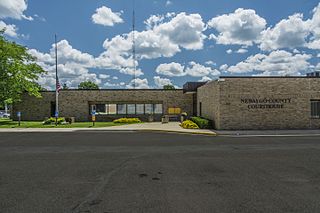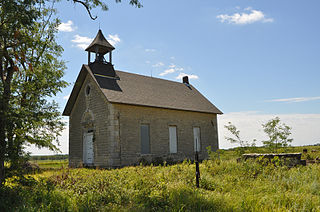
Ross County is a county in the Appalachian region of the U.S. state of Ohio. As of the 2010 United States Census, the population was 78,064. Its county seat is Chillicothe, the first and third capital of Ohio. Established on August 20, 1798, the county is named for Federalist Senator James Ross of Pennsylvania. Ross County comprises the Chillicothe, OH Micropolitan Statistical Area, which is also included in the Columbus-Marion-Zanesville, OH Combined Statistical Area.

Columbiana County is a county located in the U.S. state of Ohio. As of the 2010 census, the population was 107,841. The county seat is Lisbon. The county name is derived from the explorer of the Americas, Christopher Columbus.

Newaygo County is a county in the U.S. state of Michigan. As of the 2010 United States Census, the population was 48,460. The county seat is White Cloud. The county was created in 1840, and was organized in 1851. It was either named for an Ojibwe leader who signed the Treaty of Saginaw in 1819 or for an Algonquian word meaning "much water".

Salem Township is a civil township of Washtenaw County in the U.S. state of Michigan, located northeast of Ann Arbor. At the 2010 census, the township population was 5,627.

Danbury is a city located in Danbury Township, Stokes County, North Carolina. As of the 2010 census, the city had a total population of 189. It is the county seat of Stokes County. Danbury is located on NC 8/89 approximately 20 miles (32 km) north of Winston-Salem and is the "Gateway to Hanging Rock". The Stokes County Government Center, Arts Council, school board, county jail, a public library, a post office, and other public services are found within the town limits. LifeBrite Community Hospital of Stokes is located about a half mile northwest of the town.

North Fayette Township is a township in Allegheny County, Pennsylvania, United States. The township is a suburb of Pittsburgh. The population was 13,680 at the 2010 census. The township has been home to the Park Lane Office center since 1989.

Bristol Township is a township in Bucks County, Pennsylvania, United States. The population was 54,582 at the 2010 census, making it the 13th largest municipality in the state. Bristol Township, along with Bristol Borough, is a cultural hub for Lower Bucks County, hosting celebrations of African and Latino heritage. Parts of the township consist of the neighborhoods of Fairless Hills and Levittown, Pennsylvania.

Butler Township is a township in Schuylkill County, Pennsylvania, United States. Formed in 1848 from part of Barry Township, it is named for war hero William Orlando Butler.

Washington Township is a township in Westmoreland County, Pennsylvania, United States. It was founded in 1789 from Salem Township. At that time it included the present-day municipalities of Allegheny, Lower Burrell, Upper Burrell, and most of Bell. In 2000, the population of Washington Twp was 7,384.

Washington Township is a township in York County, Pennsylvania, United States. The population was 2,673 at the 2010 census.

Elizabethtown-Kitley is a township in eastern Ontario, Canada, in the United Counties of Leeds and Grenville. Its southern border lies along the St. Lawrence River and it extends north into many rural hamlets and villages. The township was created on January 1, 2001 by the amalgamation of the former Township of Elizabethtown and Township of Kitley.

Recess is a general term for a period in which a group of people are temporarily dismissed from their duties.

One-room schools were commonplace throughout rural portions of various countries, including Prussia, Norway, Sweden, the United States, Canada, Australia, New Zealand, the United Kingdom, Ireland, and Spain. In most rural and small town schools, all of the students met in a single room. There, a single teacher taught academic basics to several grade levels of elementary-age children. While in many areas one-room schools are no longer used, it is not uncommon for them to remain in developing nations and rural or remote areas. Examples include remote parts of the American West, the Falklands, and the Shetland Islands.

Renaissance College is a private independent international school run by English Schools Foundation (ESF) in Hong Kong. Located in Ma On Shan, Renaissance College serves primary and secondary students. The school was founded in 2006 to replace the Phoenix International School, another school run by ESF. Since its inception, the school has offered the IB Primary Years Programme, Middle Years Programme and Diploma Programme. Renaissance College began to offer the IB Career-Related Programme in 2014.
On October 2, 2006, a shooting occurred at the West Nickel Mines School, an Amish one-room schoolhouse in the Old Order Amish community of Nickel Mines, a village in Bart Township, Lancaster County, Pennsylvania. Gunman Charles Carl Roberts IV took hostages and shot eight out of ten girls, killing five, before committing suicide in the schoolhouse. The emphasis on forgiveness and reconciliation in the Amish community's response was widely discussed in the national media. The West Nickel Mines School was torn down, and a new one-room schoolhouse, the New Hope School, was built at another location.

The Schoolhouse is an exhibit building at Shelburne Museum in Shelburne, Vermont. It was originally located in Vergennes, Vermont.

The historic Abbe Creek School is a one-room schoolhouse museum located one mile west of Mt. Vernon, Iowa, on E48. It is believed to be the oldest standing one room brick schoolhouse in Iowa. The school is located on land claimed by William Abbe, the first white settler in Linn County, Iowa.

Nantwich Grammar School, later known as Nantwich and Acton Grammar School, is a former grammar school for girls and boys in Nantwich, Cheshire, England. It now forms part of the mixed comprehensive school, Malbank School and Sixth Form College.

In the late 19th and the first half of the 20th century, one room schools were commonplace throughout rural Kansas. In most rural schools, all of the students met in a single room. One room meant one teacher who taught basic reading, writing, and arithmetic to both boys and girls of all grades. When one-on-one instruction was necessary, the teacher would call a student forward to the recitation desk.

The Dedham Public School System is a PK–12 graded school district in Dedham, Massachusetts. It is the oldest public school system in the United States.



















